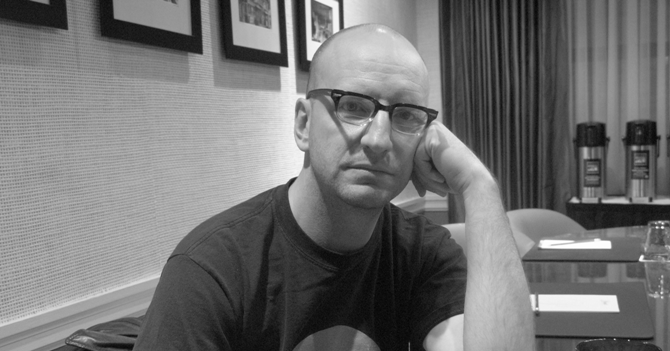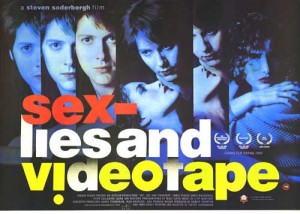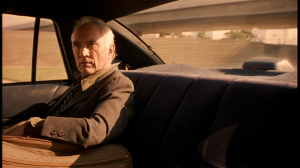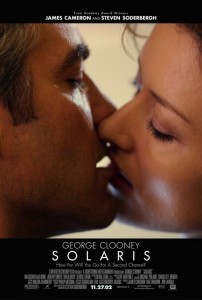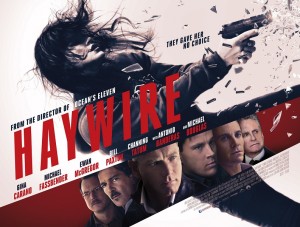Soderbergh is consistently one of the most interesting American filmmakers. He’s not often the screenwriter of his projects, but he’s certainly an auteur in every other way I can think of. With an admirably lean, economical cinematic style, he never panders to his audience, and in his 24 years of filmmaking has made a number of stone cold classics.
For more on Soderbergh and his plans, go here and here. And for my thoughts on his best work, read on.
sex, lies, and videotape (1989) was credited as having launched the American indie-film revolution of the 1990s, the film is a gem of low-budget filmmaking, with limited sets, mostly interiors and four great performances.
It’s about a buttoned-down Baton Rouge couple, Ann (Andie MacDowell) and John (Peter Gallagher), whose lives are thrown into turmoil when an old friend of John’s, Graham (James Spader), visits. Graham has some, let’s say, “issues” with intimacy. He’s made a project of interviewing women, videotaping them talking about sex. And when he videotapes Cynthia (Laura San Giacomo), Ann’s sister—who also happens to be having an affair with John—the interpersonal dynamics suddenly change. Utterly free of the stylistic conceits of the 1980s—many of which haven’t aged well—this movie really holds up.
Out of Sight (1998) showed up after years of Soderbergh pursuing a series of largely under-performing films—I haven’t seen all from this period (including Kafka, King Of The Hill, and Schizopolis) though I did appreciate elements of his chilly thriller The Underneath in 1995—and wowed audiences with a thoughtful, funny and involving crime picture; the single best Elmore Leonard adaptation put to screen, and I’ll stand on my copies of Jackie Brown and Get Shorty to say that. Soderbergh gave George Clooney his breakout role as the terminally unlucky but exceedingly charming Jack Foley. Arrayed around him are great parts for Dennis Farina, Albert Brooks, Catherine Keener, Ving Rhames, Steve Zahn, Don Cheadle and especially Jennifer Lopez, who’s never been better. The scene in the hotel bar and the love scene following between her Karen Sisko and Clooney’s Foley, with the snow softly falling outside, has to be one of the sexiest in cinema history.
Though he played with storytelling chronology in Out of Sight, he truly fragmented it with flashbacks and forwards in The Limey (1999), a revenge drama about an aging British thug (ably played by Terence Stamp) who travels to California to find the people he thinks are responsible for his daughter’s death.
Soderbergh went so far as to use footage of a much-younger Stamp from Ken Loach’s 1967 drama Poor Cow, a great technique I don’t think I’ve seen before or since.
Though I know Erin Brockovich (2000) still divides people—usually in the Julia Roberts: Love Her or Hate Her camps—it’s a great social cause movie, based on a true story, one that can stand up and wave a placard beside Norma Rae and Silkwood. And Aaron Eckhart and Albert Finney are solid in it, too.
Somehow, Soderbergh managed to get Traffic (2000) out the same year he did Erin Brockovich. Pretty frikkin’ impressive, I gotta say, especially as Traffic is a sprawling, epic docudrama about the drug trade in the US, with narratives taking place in four different locales. And Traffic earned him his Oscar for Best Director, while Benicio Del Toro took home the Oscar for Best Supporting Actor, and Julia Roberts got her Best Actress statuette, too. Hell of a year.
At this point in his career, Soderbergh is gold. He could get any project made that he wanted. Interestingly, he went high-visibility and did an entertaining remake of a drab Rat Pack heist picture called Ocean’s 11 (2001), starring many of the day’s biggest names, including Roberts, Clooney, Matt Damon, Brad Pitt—who plays a guy who wears nothing but silk and can’t stop eating—and, uh, Andy Garcia. They’re all sterling in the picture, and the movie looks spectacular. The great pleasure of the Oceans movies—including the two sequels that added Catherine Zeta-Jones and Al Pacino, respectively, to the mix—is seeing members of the old guard having so much fun: Elliot Gould and Carl Reiner have rarely been better.
Maybe the moment Soderbergh impressed me most was with his science fiction drama Solaris (2002). The Stanislaw Lem novel had famously been adapted in 1972 by Andrei Tarkovskii, but Soderbergh made it his own, casting Clooney in the solemn piece as a man who investigates what’s been happening at a deep space outpost orbiting the potentially sentient planet Solaris, only to find what could be the ghost of his wife (played by the stunning Natascha McElhone) on the station.
It’s a beautiful and moving film, with a gorgeous score by one-time Red Hot Chili Peppers drummer Cliff Martinez. Too bad more people didn’t go and see it. It’s not too late!
At this point I should also mention that Soderbergh is not only a director, he’s a producer, too, his name on a bunch of his buddy George’s films including Confessions of a Dangerous Mind, Good Night, And Good Luck and Michael Clayton, to name but a few. He’s often been the cinematographer on his own films, under the pseudonym Peter Andrews. He edits (as Mary Ann Bernard). He apparently even shot some second unit for The Hunger Games. His energy and versatility are unparalleled.
Now, I won’t say I love all of Soderbergh’s work. His peculiar, often improvised indie efforts including Bubble (2005) sometimes leave me puzzled. Full Frontal (2002) didn’t wow me, and while I admired his effort to try and make a Michael Curtiz-style post-war drama in The Good German (2006), the film was no fun at all. The Girlfriend Experience (2009) was an interesting experiment, casting a porn star (Sasha Grey) in a cool drama about an escort, and while the ambition of his two part biopic Che (2008) was impressive, it felt as though he bit off more than he could chew with that one, especially in the rambling, depressive second film. The Informant! (2009) made for an interesting character study, but otherwise didn’t reach me.
I do appreciate his filmmaking pace and risk-taking. He runs with an idea and doesn’t hesitate. There’s a lot to be said about that kind of creative philosophy. It builds an interesting, varied body of work.
Lately he’s been firing on all cylinders, as if he wanted to cram in as much quality as possible before he quits: I didn’t think Contagion (2011) entirely worked as a viral horror or a disaster movie, but its bleak realism is unrelenting and gives the movie a perfect tone. It’s perhaps the worst date movie of recent years; afterwards you don’t want to touch anything or anybody.
Multiple-international-location action picture Haywire (2012) really impressed me and wound up on my list of the Best of 2012, on which his follow-up, Magic Mike (2012), also contended. From its marketing, Magic Mike seemed like the least likely to be on anyone’s list of the best movie of any year, but it surprised me by being a funny, involving picture in the Flashdance vein, reminding us that both Channing Tatum and Matthew McConaughey, playing strippers, have serious dance movies.
On February 8, the new thriller Side Effects, starring Tatum, Rooney Mara, Jude Law and Zeta-Jones, opens, and that, according to Soderbergh, will be it. He has a film in the can for HBO, a biopic of Liberace called Behind the Candleabra, starring Michael Douglas and Matt Damon. Then there’ll be theatre and painting and TV and no more feature films.
If he ever changes his mind, I’ll be there on opening weekend. Thanks for all the good stories well-told, Mr. Soderbergh.





